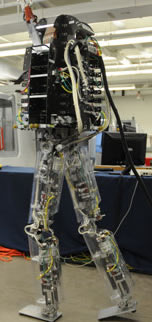Project Overview
The Urban Robotics Project is divided into several subprojects. Some of these projects such as the Biped foot and the latest iteration of the robotic vision platform (head) are senior design projects through the Mechanical Engineering Department at Bucknell University. Other projects have been performed as paid research or as graduate student work.
All of these projects are meant to work toward a common goal of producing a system that can perform efficiently and effectively in an urban environment.
Explanation of Purpose (from project proposal):
To date unmanned ground vehicles (UGVs) have largely been used for limited operations such as cave exploration, improvised explosive device (IED) detonation, and under-vehicle inspection. For joint military operations on urbanized terrain (MOUT) there is still a need for more capable platforms that can operate in cluttered streets and inside buildings. According to the World Health Organization, more than 60 percent of the world's population is expected to live in cities by 2025 and nearly 70 percent of these cities are near the coastline or surrounding areas, known as "littorals," within reach of sea-based forces.
One of the main reasons for the current deficiency of UGVs in urban areas is the poor mobility of these platforms in the challenging urban environment. Urban environments are well suited for things that are skinny and tall, such as the people they are designed for. A typical person can effortlessly squeeze between two tables separated six inches apart and grab a book from a shelf at seven feet. They can step over gaps and barriers, maneuver over piles of rubble, and go up cluttered stairs. Most current robots are nowhere near matching those capabilities. Before robots will be useful in complex urban environments, much research on robots with advanced mobility must be performed.
To address these issues we are developing reconfigurable robots, like the Urban Warrior Robot, and humanoid robots, like our Bipedal Walking Robot. Our Bipedal Walking Robot is a lower-body biped with a total of 12 degrees of freedom: 3 degrees of freedom at each hip, one at each knee, and two at each ankle. Currently it can stand and balance on one or two legs, recover when moderately pushed, and walk slowly on flat ground. The Urban Warrior Robot is an innovative reconfigurable robot that combines the advantages of a traditional wheeled drive system with a reconfigurable body and dynamic balancing. The current version of the robot has two main drive wheels, two articulated shoulder joints and two active arm wheels. It is able to maneuver in a four-wheeled low profile Transit Configuration, a four-wheeled high profile Surveillance Configuration, and a two-wheeled high profile Engagement Configuration.
Robots like the Urban Warrior Robot and the Bipedal Walking Robot may complement each other well in urban operations. The UWR can be fast and less complex than the biped and carry a heavy payload, but will not be able to get as many places as the biped. The biped will be slower and more complex, with a smaller payload, but should be able to access many of the places that a human can.
